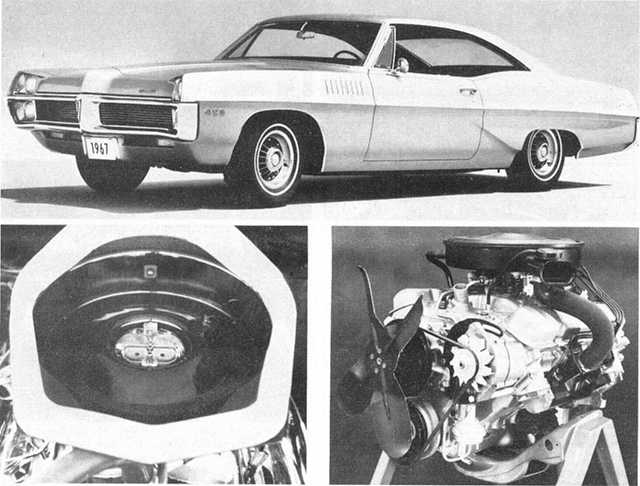
Top: The 1967 2+2 had the new 428 engine available. Above, left: extra-cost Ram Air option on GTO featured functional scoop, high-output cam and springs. The axle was a 4.33! At right is Pontiac's 455 V-8, which was rated at 455 horses and standard on the Bonneville. |
In the engine department, the 421 Super Duty, was also refined. New cylinder heads had the same valve sizes but larger ports. New valve springs and lighter valves let the engine rev higher. A new transistor ignition was added and the dual 4-barrel intake manifolds was made slightly higher to give more ram effect. Two different sets of exhaust headers were offered. On drag engines, the aluminum headers were continued. But since they melted at high temperatures, the factory also had available a set of stamped, welded steel headers for the NASCAR boys. This was the first time tubular steel headers were offered off the assembly line.
There were actually three Super Duty engines in 1963. All were 421s. The single 4-barrel NASCAR engine with 12 to 1 compression ratio rated 390 horsepower. The dual quad 421 with 12-to-one compression was rated 405 horses. The super Super Duty drag engine included special 13-to-one pistons to bring the engine up to 41 0 horses.
In the spring of 1963, the infamous GM ban on racing took hold and only a few of the Swiss cheese Catalinas were built. Production of the racing 421 engines also ceased. Royal Pontiac ran their Swiss cheese car all year in B/FX class and won all the laurels there.
A new twist was added to Pontiac's '63 street engine lineup. Or maybe we should say twister. A street version of the 421. The old 425-A Trophy engines of 333 and 348 horsepower were dropped. In their place were detuned versions of the 421 with a single 4-barrel and tripower. These engines had hot hydraulic camshafts, 10.75 compression and long branch exhaust manifolds. The 4-barrel rated 353 horsepower at 5000 rpm and the tripower setup was called 370 horsepower at 5200 rpm. The tripower street 421 was the strongest street engine available in 1963 by far, although it never did much on the dragstrips in the lower stock classes.
By '63, Pontiac product planners knew that without the racing successes to count on, and with the big Pontiacs growing heavier by the minute, their hard won position at the top of the performance image heap was going to crumble fast.
Enter the GTO. The GTO is said to have been the brainstorm of Jim Wangers. Wangers, the guy who drove the Royal Pontiac drag cars so often, was the Pontiac account executive at MacManus, John and Adams, Pontiac's advertising agency. He was also influential in product planning circles. He knew the image would need a boost and decided to drop the big Bonneville 389 engine in the new intermediate Tempest series, add on heavy duty chassis components and a flashy name. It wouldn't be a racing car, so frowned upon in the GM executive washroom. No, this would be a high performance street machine. There's a big difference, one that Ford Motor Company never learned in all their racing years.
NEXT >
|